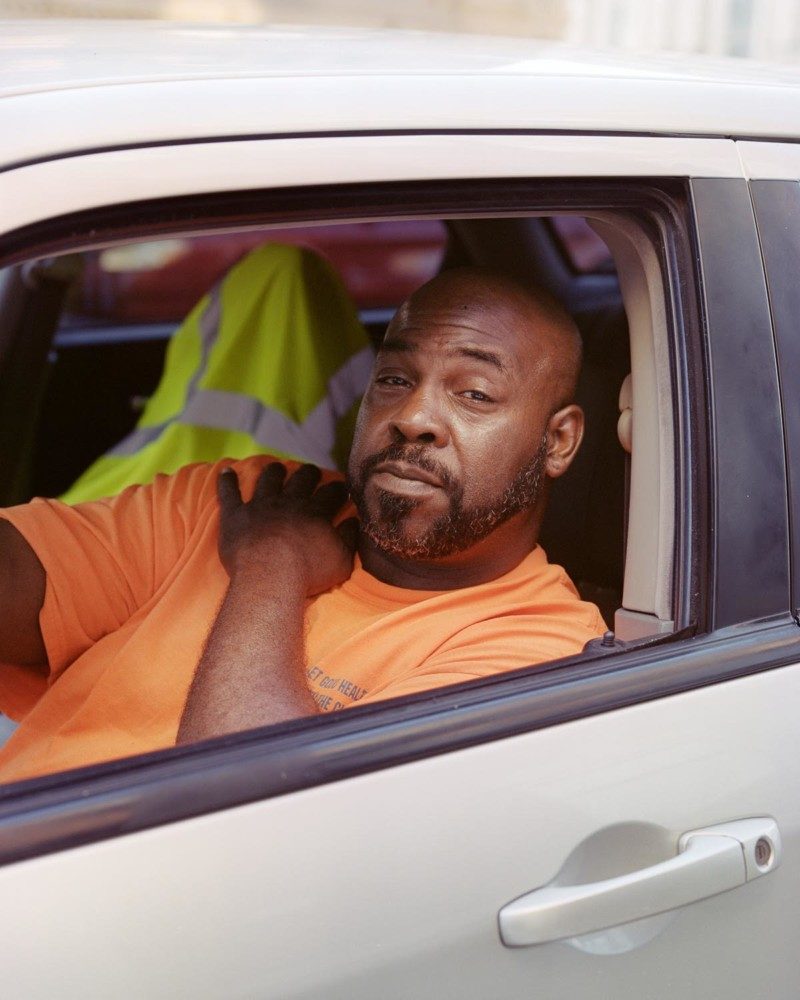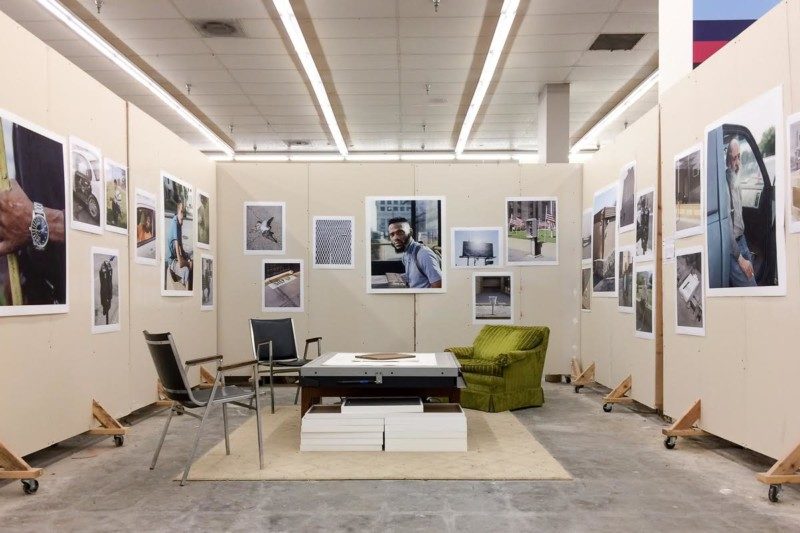Adam J Long was born in Washington state in 1978. He studied photography in Los Angeles, California (BA), Sunderland, England (MA) and Hartford, Connecticut (MFA). His photographs have been exhibited internationally and are in the permanent collection of the Nelson Atkins Museum of Art, The Hirsch Library – Museum of Fine Arts Houston, and the Colorado Photographic Arts Center. His second self-published photobook, Incline | Decline, will be released in 2017. He currently resides in Kansas City with his wife and three children where he teaches photography.

Portrait – 13th and Charlotte

Parking meter – 8th and Superior
Incline | Decline
I am a photographer particularly interested in the medium’s ability to render a description of the world that seems factual and accurate. My photographs are documentary in nature – a representation of visual elements that existed in front of me at a given time. The use of metaphor and the photograph’s ability to point to things larger and more extensive than what is within the frame sits at the crux of my practice. The sequencing of my photographs is a subjective process that provides a slippery terrain for the viewer to navigate; the expectation of “truth,” onset through a traditional use of the medium, clashing with my subjective motivations behind the organization are important aspects of my visual communication.

Payphone – Jackson County Circuit Court

Portrait – 11th and Grand
Hey, Adam, could you briefly speak about your series, “Incline | Decline”, and if there was a personal event that spurred you to create it?
This series started a few years ago when I went downtown, parked, and noticed I was in the “Financial District.” The idea of a Financial District seems to imply “hey… there is money here… this place can help.” So, I am like many – I have debt and struggle to support my family with my 3 jobs. I took this financial-district-sign as a “sign” and decided to check this area out. The project started with the notion that I, like so many people nowadays, am stressed financially and there’s gotta be something down here that can speak to this situation.

Billboard – 15th and Charlotte

Watch – 12th and Mcgee
I feel like this series is a ballad written for America, one that evokes a certain sadness in its overt Patriotism. For instance, I feel this in the image with the outdated, thus neglected, payphone surrounded by American flags. Can you discuss the melancholic nature of your photography?
That’s tricky… I risk sounding like a crybaby who won’t suck it up and work harder. Plenty of us on the lower rungs of this financial food chain keep spinning our wheels, with both hands firmly gripped on our fucking bootstraps and it got old a long time ago. I don’t navigate my life kicking cans down the street all downtrodden, my work provides an avenue for me to understand this in a different way. Overall I am thankful for what I have – but this notion of the American dream (the “overt Patriotism” comment seems to imply this) and its brokenness, is a consistent metaphor, maybe even a factual condition, found in this Financial district. I can see that the work is melancholy but it’s also a remonstration – seen in images like the “Have Gratitude” billboard. What is happening around us is deplorable and we are in a mess of cataclysmic proportions.

Watch – 12th and Mcgee

Portrait – 9th and Harrison
How have your feelings of our current political climate changed the way you currently interact with this series of images?
I started this work two years ago – long before the current deluge of excrement started raining down. It does seem to be coinciding with current events at this point, but the work was not initially intended to be political. As it turns out it is quite political– even beyond the truism that all art is political. Again, I knew the Financial district was going to be the overarching metaphor of the work – but how I bring that up and talk about the issue through photographs aligns with the ambitious goal that Lewis Baltz touched on – “Anyone can take pictures, what is difficult is thinking about them, organizing them, trying to use them so that some meaning can be constructed out of them – that’s where the work begins.” But to answer your question, the politics of now are affecting me and I am internalizing them and eventually they will reach my fingertips – there is no getting around it. And let’s face it, people need to be exposed to these issues in a different way… this election has created an absolute polarization where the ability to converse through traditional means appears to have all but dried up.

Car – 13th and Charlotte

Bird – 9th and Cherry
In your artist statement, you write how you are “particularly interested in the medium’s ability to render a description of the world that seems factual and accurate.” How does your photography practice maneuver through the continuous onslaught and- to a certain extent- lack of integrity within the news?
That’s a pretty interesting question – the thing about my work, being documentary in nature, is that it skates that line which Andy Grundberb said, “What we see in photographs is often mistaken for the real thing.” My work might look “factual and accurate” but ultimately it is my truth – this is what I believe. I don’t want the work to be didactic – I want the viewer to work in order to be involved and to figure things out – to have that discovery I had. I’m interested in photography’s ability to infiltrate our minds and shape our thinking in a subtle pervasive way. My work is not journalism but it does have the “boots on the ground” mentality found in journalism, I do explore and find as a journalist often does, which potentially provide the antidote for fake news stories.

Meter – 8th and Cherry

Portrait – 10th and Locust
I have had the privilege to see your work at your place of work, the University of Kansas, and in a book form. How do you think your photographs operate differently in either medium?
With this work, in particular, I want to create a space for the viewer to be challenged, have empathy, and to confront the reality that things are breaking all of the time, and it’s about to get a lot worse. I have been working out my ideal exhibition needs in my studio where the prints have various sizes. For this project, “traditional” work displayed in a “traditional” manner doesn’t cut it for me. I don’t think the viewer should “get it” from across the gallery, or from 2 feet away, or anywhere in-between. Smaller print sizes encourage the viewer to get close – noticing nuance, and larger prints encourage them to back up – establishing context. I believe that the message of the work elucidates when viewers become aware of the nuance of an image in context with the whole. The book is a totally different experience, although, those central ideals of what I want from the wall carry over. My current sequence solely contains double spreads… again, it denies that idea of traditional page-right photobooks. This work benefits from interaction with other photographs – those image pairings (as well as the sequence) are the bane of my existence… many nights have been spent with Tupac or Johnny Cash hashing out different arrangements.

Trashcan – 9th and Cherry

Truck – 8th and Superior
What do you feel is the redemptive quality of your work, especially in the wake of our country’s tumultuous political situation?
Wow, great question – I really like that word redemptive. When I encounter people and I make their portraits (this is a little hard for me to talk about actually…) I feel a kind of intense empathy and I don’t know where it comes from (but I am grateful for it). People’s situations can be really heartbreaking to me. From that point of reference, I seem to have a very fortunate, privileged life… even though working as an adjunct professor with 4-6 classes a week at multiple schools and waiting tables 3 nights a week is oftentimes exhausting for me. Robert Adams wrote “photography as art does address evil, but it does so broadly as it works to convince us of life’s value; the darkness that art combats is the ultimate one, the conclusion that life is without worth and finally better off ended. Which is to say that art addresses an inner struggle whereas journalism more often reports on the outward consequences of it. Perhaps this is what William Carlos Williams meant when he wrote that ‘It is difficult/to get the news from poems/yet men die miserably every day/for lack/of what is found there… and though poems and pictures cannot by themselves save anyone – only people who care for each other face to face have a chance to do that – they can strengthen our resolve to agree to live’.” I think that’s redemptive… I hope an ounce of that is in my portraits because it might remind viewers of life’s interconnectivity. I may be making these pictures, but the people I’m photographing are giving me that opportunity, and, in a sense, creating my work. Personally, as I meet people and hear a bit about them, I situate them in the context of others, and in the context of me… I’m convinced that’s what we need in our current political situation – a willingness to discover the reality that generosity is necessary. It’s obvious that the man who is about to pilot our ship isn’t interested in that in the least. This is deeply concerning because it is how societies collapse… I don’t want that to happen.

Portrait – 10th and Oak

Studio – The Drugstore KC
To view more of Adam’s work, please visit his website.